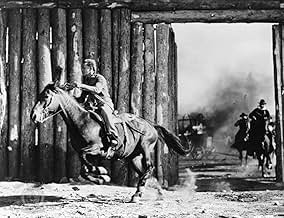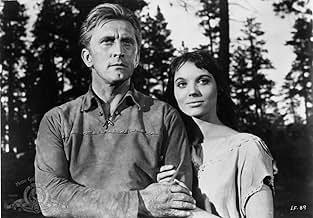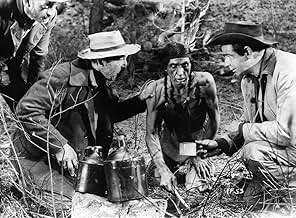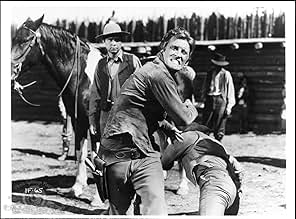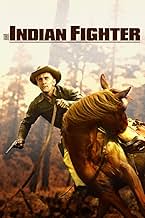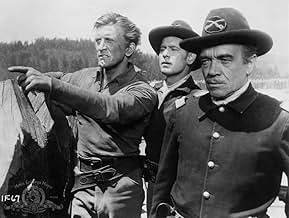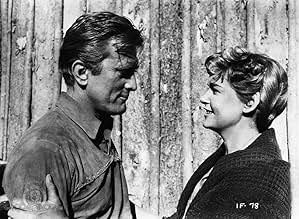IMDb रेटिंग
6.3/10
3 हज़ार
आपकी रेटिंग
जटिल भारतीय इलाके में मालगाड़ी का नेतृत्व करने वाला एक स्काउट अनजाने में एक सियु प्रमुख की बेटी के प्रति आकर्षित हो जाता है.जटिल भारतीय इलाके में मालगाड़ी का नेतृत्व करने वाला एक स्काउट अनजाने में एक सियु प्रमुख की बेटी के प्रति आकर्षित हो जाता है.जटिल भारतीय इलाके में मालगाड़ी का नेतृत्व करने वाला एक स्काउट अनजाने में एक सियु प्रमुख की बेटी के प्रति आकर्षित हो जाता है.
- निर्देशक
- लेखक
- स्टार
Lon Chaney Jr.
- Chivington
- (as Lon Chaney)
Alan Hale Jr.
- Will Crabtree
- (as Alan Hale)
Elisha Cook Jr.
- Briggs
- (as Elisha Cook)
Lane Chandler
- Head Settler
- (बिना क्रेडिट के)
Robert 'Buzz' Henry
- Lt. Shaeffer
- (बिना क्रेडिट के)
फ़ीचर्ड समीक्षाएं
I remember having enjoyed very much this film as a kid back in the 50's, but not when I saw it again a couple of years ago. The story is not better or worst than that of many other westerns -a scout leads a wagon train through hostile Indian territory- but Andre de Toth's direction is weak and completely standard; these are things you don't notice in films as a kid when you're more interested in cowboys and Indians fights and action scenes. In my opinion, De Toth was just an average director that will probably be remembered for his earlier work in "House of Wax" (1953) when aided by an interesting plot and an excellent Vincent Price he achieved a little classic in the horror genre; but he never reached the mark later.
As for "The Indian Fighter", you can rescue Kirk Douglas undeniable strong screen presence, one of Walter Mattau's early roles as a villain and the sensual Italian actress Elsa Martinelli as an Indian squaw that gets mixed up with Douglas.
But there's not much more in this average and common film, only for fans of the genre or good old Kirk (in his late thirties back then).
Just for the record: in Argentina "The Indian Fighter" was renamed as "A un Paso de la Muerte" (something like "Just One Step Away from Death").
As for "The Indian Fighter", you can rescue Kirk Douglas undeniable strong screen presence, one of Walter Mattau's early roles as a villain and the sensual Italian actress Elsa Martinelli as an Indian squaw that gets mixed up with Douglas.
But there's not much more in this average and common film, only for fans of the genre or good old Kirk (in his late thirties back then).
Just for the record: in Argentina "The Indian Fighter" was renamed as "A un Paso de la Muerte" (something like "Just One Step Away from Death").
At the heart of De Toth's oeuvre lies an interesting contradiction. He has an abiding interest in suspense, action, and the wellspring of violent events (a fact underlined by the number of thrillers, frontier yarns and dramas he helmed during his career), but, as a director, characteristically disassociates himself from their process. This 'distancing' effect has been noted by a number of viewers, creating some critical debate about De Toth's engagement with his material. In my view his detachment is not to be confused with aloofness - an interesting comparison can be made with Stanley Kubrick's alleged 'coldness' - but is rather De Toth's way of resolving what really 'matters'. It is this intelligence, revealing itself sharply in his best films, that makes him such a worthwhile study.
Along with De Toth's assured debut 'Ramrod' (1947) and the austere 'Day of the Outlaw' (1959), 'The Indian Fighter' is probably the finest of his Western films, revealing a characteristic response to the demands of the genre. In 'Ramrod' the moral questing springs from a noirish plot that is unsettled and full of tension. In 'Day of the Outlaw' issues are resolved more formally, played out against the stark landscape of Winter. In 'The Indian Fighter', De Toth's concerns manifest themselves in his most lyrical and sensuous work. He thereby creates a film which, in emphasis, is in direct contrast to most other 50's Westerns.
This is ostensibly a tale of a famous frontiersman Johnny Hawks (played with usual lusty gusto by Kirk Douglas), back from the wars. Ultimately he has to redeem his reputation, discovering balance within the indigenous people he has previously warred against. Gold has been discovered on Indian land, and the bad guys (a marvellous performance by Walter Matthau, ably supported by Lon Chaney, Jnr) are out to kill and cheat to secure the riches. This, and the related fear of a tribal uprising, provide the main action point of the film.
As the Indian fighter of the title, ironically the first thing we notice about Hawks is his reticence. In fact he hardly fights at all - only when he is obliged, or when called upon to at the climax of the film. For him, combat is not a prerequisite, although he is not slow to react when needs be. A comparison with the bitterness of Ethan Edwards, say, in Ford's 'The Searchers' is revealing. Edwards loathes the Commanches, with a bitterness entirely absence from De Toth's hero. As Hawks' opponents observe, he is more of an Indian lover than fighter. And, of course, in the most obvious way, they are right. Almost more important to the hero than his professional reputation is his preoccupation with the Indian maid Onhati. His single-minded pursuit, and later dalliance, with her initiates the main crisis of the film, as he leaves the wagon train to be by her side, after taking it 'two days out of my way and half way up a mountain'.
This is a film full of sensuality, placed in contrast to 'duty', the calling of action. We are constantly reminded of the cool pools, green foliage, closeness of the earth, just as much as of the teachery and turmoil of the frontier. Franz Waxman's score is lyrical and evocative, frequently idyllic. The glorious cinematography gives nature's perpetual garden a pantheistic gloss, sometimes intense, and always resplendent. Just as the main film captures these images, so in mimicry does Briggs, a supposed protégé of civil war photographer Matthew Brady, who frequently accompanies Hawks. He is eager to capture the grandeur around him. His camera is as significant to us as it is to Hawks, who makes a point of rescuing it at one point (during the battle at the fort). An important minor character, Briggs emphasises the appreciation of the sublime and beautiful that the film invites. A couple of times De Toth pauses the action (once at the fort and then at the wagon train), to pan his camera for long seconds along sets and people, recording their place in the Oregon landscape. Like Briggs he wants to admire, and record.
A circular film, 'The Indian Fighter' begins with Hawks gazing at Onhati bathing naked in a pool. It ends with him joining her in the water, forming a happy couple. The whole world of action is thus enclosed by their bonding, their sensual preoccupation usurping the violent demands of Indian-white conflict.
The scenes between the two lovers caused a murmur at the time. Considered 'risque' for the conservative 50's Western, De Toth simply inserted them, and their sexual self-absorption, as entirely fitting his plan of things. What is more eyebrow-raising today is how he allowed the encounters between two lovers to backstage the expected intrigues of masculine action, and actually assume greater significance, reversing regular audience expectations. This stress, an essentially feminine one. is completely uncharacteristic of the Western at this time. Add to that a sympathetic view of Indians and nature conservation (the Indian Chief's environmental concerns are a main reason for his refusing to exploit the land with mining) and you have an excellent film - a career highlight of this greatly underrated director.
Along with De Toth's assured debut 'Ramrod' (1947) and the austere 'Day of the Outlaw' (1959), 'The Indian Fighter' is probably the finest of his Western films, revealing a characteristic response to the demands of the genre. In 'Ramrod' the moral questing springs from a noirish plot that is unsettled and full of tension. In 'Day of the Outlaw' issues are resolved more formally, played out against the stark landscape of Winter. In 'The Indian Fighter', De Toth's concerns manifest themselves in his most lyrical and sensuous work. He thereby creates a film which, in emphasis, is in direct contrast to most other 50's Westerns.
This is ostensibly a tale of a famous frontiersman Johnny Hawks (played with usual lusty gusto by Kirk Douglas), back from the wars. Ultimately he has to redeem his reputation, discovering balance within the indigenous people he has previously warred against. Gold has been discovered on Indian land, and the bad guys (a marvellous performance by Walter Matthau, ably supported by Lon Chaney, Jnr) are out to kill and cheat to secure the riches. This, and the related fear of a tribal uprising, provide the main action point of the film.
As the Indian fighter of the title, ironically the first thing we notice about Hawks is his reticence. In fact he hardly fights at all - only when he is obliged, or when called upon to at the climax of the film. For him, combat is not a prerequisite, although he is not slow to react when needs be. A comparison with the bitterness of Ethan Edwards, say, in Ford's 'The Searchers' is revealing. Edwards loathes the Commanches, with a bitterness entirely absence from De Toth's hero. As Hawks' opponents observe, he is more of an Indian lover than fighter. And, of course, in the most obvious way, they are right. Almost more important to the hero than his professional reputation is his preoccupation with the Indian maid Onhati. His single-minded pursuit, and later dalliance, with her initiates the main crisis of the film, as he leaves the wagon train to be by her side, after taking it 'two days out of my way and half way up a mountain'.
This is a film full of sensuality, placed in contrast to 'duty', the calling of action. We are constantly reminded of the cool pools, green foliage, closeness of the earth, just as much as of the teachery and turmoil of the frontier. Franz Waxman's score is lyrical and evocative, frequently idyllic. The glorious cinematography gives nature's perpetual garden a pantheistic gloss, sometimes intense, and always resplendent. Just as the main film captures these images, so in mimicry does Briggs, a supposed protégé of civil war photographer Matthew Brady, who frequently accompanies Hawks. He is eager to capture the grandeur around him. His camera is as significant to us as it is to Hawks, who makes a point of rescuing it at one point (during the battle at the fort). An important minor character, Briggs emphasises the appreciation of the sublime and beautiful that the film invites. A couple of times De Toth pauses the action (once at the fort and then at the wagon train), to pan his camera for long seconds along sets and people, recording their place in the Oregon landscape. Like Briggs he wants to admire, and record.
A circular film, 'The Indian Fighter' begins with Hawks gazing at Onhati bathing naked in a pool. It ends with him joining her in the water, forming a happy couple. The whole world of action is thus enclosed by their bonding, their sensual preoccupation usurping the violent demands of Indian-white conflict.
The scenes between the two lovers caused a murmur at the time. Considered 'risque' for the conservative 50's Western, De Toth simply inserted them, and their sexual self-absorption, as entirely fitting his plan of things. What is more eyebrow-raising today is how he allowed the encounters between two lovers to backstage the expected intrigues of masculine action, and actually assume greater significance, reversing regular audience expectations. This stress, an essentially feminine one. is completely uncharacteristic of the Western at this time. Add to that a sympathetic view of Indians and nature conservation (the Indian Chief's environmental concerns are a main reason for his refusing to exploit the land with mining) and you have an excellent film - a career highlight of this greatly underrated director.
"The Indian Fighter" was filmed entirely in the outdoor beauty of Oregon. The scenery and color are breathtaking. The action scenes are expertly staged and executed, particularly the Indian attack on the fort.
Kirk Douglas stars in the title role as a scout who is hired to guide a wagon train through Indian Territory to Oregon. Walter Matthau (in an early role) and Lon Chaney (wasted again) play the villains of the piece who start up an Indian war by trying to steal gold from their land. Eduard Franz plays Red Cloud the Sioux chief who tries to keep the white man from encroaching on his people's land.
Elsa Martinelli is an Indian maiden who becomes Douglas' main love interest and Diana Douglas (Kirk's wife at the time and mother of MIchael) plays a settler woman with designs on Kirk but who has to settle for hard-working Alan Hale instead. I wonder how Diana Douglas felt about Kirk rolling around in a creek with Ms. Martinelli?
Rounding out the cast are a number of familiar faces. Walter Abel plays the army captain, Elisha Cook a frontier photographer and Ray Teal, Frank Cady and Lane Chandler as various settlers.
"The Indian Fighter" rises a step above similar westerns through its beautiful scenery and exciting action sequences. It is a truly exciting and colorful outdoor adventure.
Kirk Douglas stars in the title role as a scout who is hired to guide a wagon train through Indian Territory to Oregon. Walter Matthau (in an early role) and Lon Chaney (wasted again) play the villains of the piece who start up an Indian war by trying to steal gold from their land. Eduard Franz plays Red Cloud the Sioux chief who tries to keep the white man from encroaching on his people's land.
Elsa Martinelli is an Indian maiden who becomes Douglas' main love interest and Diana Douglas (Kirk's wife at the time and mother of MIchael) plays a settler woman with designs on Kirk but who has to settle for hard-working Alan Hale instead. I wonder how Diana Douglas felt about Kirk rolling around in a creek with Ms. Martinelli?
Rounding out the cast are a number of familiar faces. Walter Abel plays the army captain, Elisha Cook a frontier photographer and Ray Teal, Frank Cady and Lane Chandler as various settlers.
"The Indian Fighter" rises a step above similar westerns through its beautiful scenery and exciting action sequences. It is a truly exciting and colorful outdoor adventure.
Filmed in Oregon, Andre De Toth's film is a frontier adventure tale of the Great Sioux Nation whose heritage and culture run through the silver screen like a strong steady stream...
The motion picture touches up new ground by giving Indians a little sex appeal... Douglas, as a vigorous frontier scout, tries to attract the Indian maiden Onahti, played by the attractive brunette Elsa Martinelli... The Italian actress is seen bathing in the fresh waters of a river and later captured nude in a transparent voluminous stream...
"The Indian Fighter" concerns the efforts of a wagon train heading for Oregon in 1870... The train stops at a small frontier fort when the Sioux forbid them to pass through their territory... A seasoned scout and Indian expert, Johnny Hawks (Douglas), is assigned by the army to aid them...
Hawks rapidly goes to the camp of the dignified Chief Red Cloud (Eduard Franz) who explains that the trouble was started by white whiskey traders, trying to rob the Indians of their gold...
Hawks promises to settle th situation and the Chief agrees to appear at the fort to sign a peace treaty... However, his aggressive brother Grey Wolf (Harry Landers) repudiates peace talk because he despises all white men as dishonorable...
Douglas' portrait of Hawks is suitably vigorous and possibly comes close to depicting the actual character of such a man - Hawks is a jealous self-confident man who considers the West as his milieu... He declines to open up the West for civilization... He considers the West as 'a beautiful woman' and refuses to share her with anybody... He is a brave warrior who fights Sioux-style, and a shooter who never miss a snake... He respects the Indians as vanquished valiant enemies who deserve to be treated as human beings...
The motion picture touches up new ground by giving Indians a little sex appeal... Douglas, as a vigorous frontier scout, tries to attract the Indian maiden Onahti, played by the attractive brunette Elsa Martinelli... The Italian actress is seen bathing in the fresh waters of a river and later captured nude in a transparent voluminous stream...
"The Indian Fighter" concerns the efforts of a wagon train heading for Oregon in 1870... The train stops at a small frontier fort when the Sioux forbid them to pass through their territory... A seasoned scout and Indian expert, Johnny Hawks (Douglas), is assigned by the army to aid them...
Hawks rapidly goes to the camp of the dignified Chief Red Cloud (Eduard Franz) who explains that the trouble was started by white whiskey traders, trying to rob the Indians of their gold...
Hawks promises to settle th situation and the Chief agrees to appear at the fort to sign a peace treaty... However, his aggressive brother Grey Wolf (Harry Landers) repudiates peace talk because he despises all white men as dishonorable...
Douglas' portrait of Hawks is suitably vigorous and possibly comes close to depicting the actual character of such a man - Hawks is a jealous self-confident man who considers the West as his milieu... He declines to open up the West for civilization... He considers the West as 'a beautiful woman' and refuses to share her with anybody... He is a brave warrior who fights Sioux-style, and a shooter who never miss a snake... He respects the Indians as vanquished valiant enemies who deserve to be treated as human beings...
I've always enjoyed Kirk Douglas films in general and he's usually very good in westerns. But The Indian Fighter quite frankly is a pumped up B western.
Kirk produced this one as well and was able to get a good cast of familiar faces in westerns. He even got his ex-wife, Diana Douglas to appear as a widow traveling west on a wagon train with her son.
Kirk Douglas is Johnny Hawks who is a scout guiding a wagon train west to Oregon. The film opens with him checking out the naked Elsa Martinelli taking a bath in a creek. Pleasure before business and he continues on to the village where he finds out Elsa is the daughter of Chief Eduard Franz.
And that sets the tone for the film. When Douglas should be concerned about the safety of the people he's working for, he's off trying to court Elsa. His preoccupation with her almost causes disaster to the train.
Action there is though, including a nicely staged Indian attack on an army post. And the whole film was shot in Oregon on location quite nicely. I believe some of this same area was used in Kirk Douglas's later western The Way West.
Kirk Douglas's heroes are usually flawed and quite three dimensional. But this film has a hero I could not really get a rooting interest for.
Kirk produced this one as well and was able to get a good cast of familiar faces in westerns. He even got his ex-wife, Diana Douglas to appear as a widow traveling west on a wagon train with her son.
Kirk Douglas is Johnny Hawks who is a scout guiding a wagon train west to Oregon. The film opens with him checking out the naked Elsa Martinelli taking a bath in a creek. Pleasure before business and he continues on to the village where he finds out Elsa is the daughter of Chief Eduard Franz.
And that sets the tone for the film. When Douglas should be concerned about the safety of the people he's working for, he's off trying to court Elsa. His preoccupation with her almost causes disaster to the train.
Action there is though, including a nicely staged Indian attack on an army post. And the whole film was shot in Oregon on location quite nicely. I believe some of this same area was used in Kirk Douglas's later western The Way West.
Kirk Douglas's heroes are usually flawed and quite three dimensional. But this film has a hero I could not really get a rooting interest for.
क्या आपको पता है
- ट्रिवियाKirk Douglas did most of his own horseback riding and, at one point, broke his nose attempting a stunt that called for him to make his horse fall. Instead of leaning back in the saddle when yanking the horse's head around to the side, Douglas leaned forward and took the full force of the horse's heavy head right in the face. Bill Williams was Douglas' stunt double, and "was an excellent rider [he was later killed doing a stunt for The Hallelujah Trail (1965)], and in silhouette looked a lot like me."
- गूफ़Right before the Indians tie Todd to the tree with the intention of burning him, he's having a conversation with Johnny. During this conversation, Johnny's left arm repeatedly changes positions, from being stretched out against the tree, to holding his hat in front of him and back to stretched out against the tree.
- भाव
Grey Wolf: There can be no friendship between Red Man and White. The fight is to the end. Ride back to your people. There is no room for you here.
Johnny Hawks: You've grown a big mouth since I saw you last, Grey Wolf, but I didn't come here to talk to a big mouth. I've come to talk to a big man.
- कनेक्शनReferenced in I soliti ignoti (1958)
टॉप पसंद
रेटिंग देने के लिए साइन-इन करें और वैयक्तिकृत सुझावों के लिए वॉचलिस्ट करें
- How long is The Indian Fighter?Alexa द्वारा संचालित
विवरण
बॉक्स ऑफ़िस
- US और कनाडा में सकल
- $24,50,000
- चलने की अवधि1 घंटा 28 मिनट
- पक्ष अनुपात
- 2.35 : 1
इस पेज में योगदान दें
किसी बदलाव का सुझाव दें या अनुपलब्ध कॉन्टेंट जोड़ें



